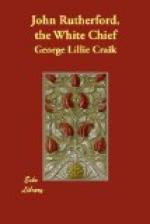[Illustration: A door-lintel, showing Maori carving. Tourist Dept. photo]
It is curious to remark how the genius of commerce—the predominating influence of a more civilized age—has seized upon more than one of these provisions of the old state of society, and converted them to its own purposes. The spacious area around the village cross, or the adjacent common, has been changed into the scene of the fair or the daily market; and the vicinity of the sea, or the navigable river, no longer needed as a protection against the attacks of surrounding enemies, has been taken advantage of to let in the wealth of many distant climes, and to metamorphose the straggling assemblage of mud cottages into a thronged and widespread city—the proud abode of industry, wealth, elegance, and letters.
Rutherford states that the baskets in which the provisions are served up are never used twice; and the same thing is remarked by Cruise. The calabash, Rutherford adds, is the only vessel they have for holding any kind of liquid; and when they drink out of it, they never permit it to touch their lips, but hold their face up, and pour the liquor into their mouth.
After dinner they place themselves for this purpose in a row, when a slave goes from one to another with the calabash, and each holds his hand under his chin as the liquor is poured by the slave into his mouth. They never drink anything hot or warm. Indeed, their only beverage appears to be water;[R] and their strong aversion to wine and spirits is noticed by almost all who have described their manners.
Tetoro, one of the chiefs who returned from Port Jackson in the “Dromedary,” was sometimes admitted, during the passage, into the cabin, and asked by the officers to take a glass of wine, when he always tasted it, with perfect politeness, though his countenance strongly indicated how much he disliked it. George of Wangaroa, the chief who headed the attack on the “Boyd,” was the only New Zealander that Cruise met with who could be induced to taste grog without reluctance; and he really liked it, though a very small quantity made him drunk, in which state he was quite outrageous. His natural habits had been vitiated by having served for some time in an English ship.
It is probable, however, that the sobriety of this people has been hitherto principally preserved by their ignorance of the mode of manufacturing any intoxicating beverage. Even the females, it would appear, have some of them of late years learned the habit of drinking grog from the English sailors; and Captain Dillon gives an account of a priestess, who visited him on board the “Besearch,” and who, having among several other somewhat indecorous requests, demanded a tumbler of rum, quaffed off the whole at a draught as soon as it was set before her.




